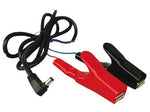You have no items in your shopping cart.
Electric Fencing Ropes and Horse Fencing Tapes.
- There is only one thing to be considered when looking at Electric fence tapes, rope or twine - that is the conductivity (the ability to transmit electricity) of the material.
- The lower the Ohms/metre is, the more electricity it will carry and deliver an effective sting. For example:- Where an energiser is used to charge 1.3 klm of fence using a good conductor (0.3 Ohms/meter) it will draw far less energy from your battery or mains than when using a poor conductor (10 Ohms/m.);- your batteries will last far longer.
Select the product range of your choice




Our electric fencing tape for horses has a wide weave that allows the wind to blow through, helping to ensure that the tape is less affected by wind under all adverse weather conditions. The Electric Fencing Tape is delivered on its own reels and is available in brown, green or white.To view the options available in the various categories - Tape, Twine, Rope or Wire - Please use the drop down feature in the menu or click on the picture above.
By its nature, electric fence tape has high electrical resistance and requires stronger power units. To mitigate this additional step, our 40mm electric fence tape is made with new alloys - TLD Max Technology - that blend the strength of different metals to create the best conducting materials that permit the use of less powerful energisers. This is the optimum width seen by animals of flight (horses, deer, zebra).
TOP TIPS FOR TAPE, ROPE AND WIRE
Do not simply tie them together, use the correct joiners to ensure correct connection of the filaments.
Make absolutely sure that the tape, rope or wire you use TOUCHES NOTHING BUT PLASTIC. Use efficient fencing insulators.
Conductivity is the key to a quality tape or rope - Ohms/meter - the lower this figure is the better the quality.
If you are in a windy area consider rope, instead of tape, because it flaps around less
Try and use substantial start/end posts if at all possible, they give the fence set up some structure and tension
ELECTRIC FENCING TAPE.
Electric poly tape provides greater visibility than poly wire and is therefore more suitable for fast moving animals. Reinforced edges help protect the tape from wear and tear. Joining poly tape is easy using tape connectors. Tape should only be pulled up hand tight, do not over tension. A tape is subject to increased wear in windy conditions. High wind resistance of wide tape will tend to blow the fence over and the wear rate increases so life expectancy will be lower than rope. The large surface area exposed to sunlight will also limit its life.
ELECTRIC FENCING POLY ROPE
Electric poly rope has less visibility than tape but is substantially more durable thus making it a good choice for a fence line particularly in exposed areas. It is stronger than poly twine. The micro filaments ensure good electrical energy is carried through the fence line at all times. Use Rope Connections to maintain a sound connection.
ELECTRIC FENCE POLY TWINE
Polytwine is a good fencing choice for temporary fences as it tends to be more visible than steel wire. It is lightweight thus making it easy to handle, install and rewind when used as a portable fence. It is well suited to strip grazing and is easily tensioned and it may be repaired quickly and easily. Poly wire is ideal for temporary grazing, strip or rotational grazing and general pasture and pet control. Should not be used with Horses.
STEEL WIRE
This section may be broken down into 2 categories;-
1/. High Tensile Wire
A high tensile wire fence system requires many unique components and is ideal for permanent installation particularly for very long farm fences. Although not right for every type of animal or enclosure, a high tensile fence is affordable, attractive, easy to maintain and can last over 20 years. High tensile wire may be strung tightly and will not stretch under a load, however - it is difficult to work with.
2/. Seven Strand Wire
7 Strand fencing wire is a non-tempered, medium-tensile wire that has a yield point and beyond that it stretches plastically under tension (Hooke's Law). This point is reached before the wire breaks so that when highly strained in a fence it will not retain its tension over long periods and will stretch. It therefore should not be tensioned to the stage where a guitar solo may be played on it and the wire requires more support stakes and posts to prevent it sagging. It is very easy to work with and will outlast any of the polyplastic materials.
* Warranty on these products cover ultra violet degradation and does not cover mechanical damage.
- Electric Netting
- Tape, Twine, Wire And Rope
- Fencing Energisers
- Fencing Posts
- Insulators
- Accessories
- Electric Fencing Kits
- Chicken Feeders and Drinkers
-
Information
- What is Electric Fencing
- Advantages of an Electric Fence
- Installing a Fence
- Is an Electric Fence a serious risk
- How to Erect a Net
- What you Need for a Fence
- Testing an Electric Fence
- Quantities Guide
- Improve Your Fence
- Poultry Netting Trial
- Electric Netting Dimensions
- Electric Fencing Mistakes
- TLD Max Technology
- Energiser Terminology
- Choosing an Energiser
- Fencing Articles
- Trouble Shooting
- Delivery Terms
- Frequently Asked Questions
- Here's a Blog Worth Reading
- Price
-
-
Below $100.00
-
$100.00-199.00
-
$200.00-299.00
-
$300.00-399.00
-
$400.00-499.00
-
Above $500.00
-
- Color
-
-
- Size
-
-
S
-
M
-
L
-
XL
-
2XL
-
3XL
-
- Brand
-
-
Adidas
-
Camel
-
Motorola
-
Rolex
-
Samsung Galaxy
-
Seiko
-
Sony
-







